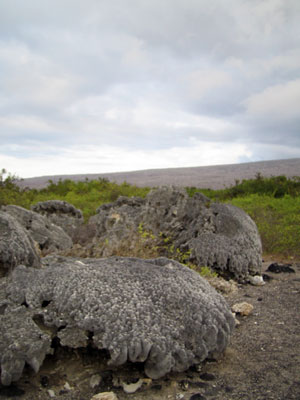|
Jan 15, 2006
Log by Trina Litchendorf
(click for larger images)
Uplifted corals

Female Darwin Ground Finch

Galapagos Hawk

Goat Bones

|
Today we got to go ashore onto Urvina Bay on the big island of Isabella for a few hours. The students, professors and ship’s crew were taken ashore in the ship’s zodiac in three groups. Byron Aguirre, who was born in the Galapagos and is a freelance naturalist trained by the Galapagos Natural Park, is on this cruise with us and he was our guide as we visited the island.
In 1954, Acedo volcano explosively erupted and the pressure of the magma underneath uplifted a 6 kilometer by 1 kilometer wide portion of the shore that was underwater out of the sea. Giant corals that had been beneath the sea were now exposed to the air and fifty years later the area is now overgrown with brush and trees. As we walked along the path, we walked by lava rocks covered in calcium carbonate that had not long ago been below the ocean. We also passed by giant brain coral; in the photograph those corals are over 6 feet wide and four feet high. Byron squatted down and scooped up a handful of what looked like gravel from the path. Upon closer inspection we could see small pieces of pumice from the eruption and shells from the uplifted area. It was strange to be walking along the path inland and see corals on the ground.
We saw the giant land iguanas while we were here, and the males tend to be more colorful than the females. These iguanas are endemic to the islands like many of the Galapagos Island’s other well-know animals, meaning they are found nowhere else on the planet except here. Also on the ground we saw many goat bones. Byron explained that introduced species such as goats are a big threat to the endemic species on the islands, destroying the habitat and competing for food. On Isabella Island there are over 200,000 goats and the park system is working to eradicate them from the islands. This is a difficult task because the islands are covered with such dense vegetation that it is difficult to find the goats in the first place. To solve this problem, the park service puts a radio collar on one goat and lets it go on the island. Being gregarious animals, the lone goat will seek out the herd of goats. The park wardens then can track where the herd is and they fly there by helicopter and shoot the goats. They then leave the radio-collared “Judas” goat free to find another herd. It may seem cruel, but to leave the goats would mean allowing many of the Galapagos Island’s unique species to face extinction.
We also saw several species of Darwin’s finches. There are 13 species of finches on the islands, and these unassuming, drab-looking little birds have had a profound impact on human thought. In 1835 when Darwin as a 25-year old naturalist on the ship Beagle, collected specimens of these birds he noticed how similar they all were though they had different types of beaks. These little birds are an excellent example of adaptive radiation, whereby these species evolved from a common ancestor that arrived on the islands many eons ago. They have evolved to exploit the different food sources available on the islands. Looking at their beaks, Darwin saw how some had thicker beaks for cracking large seeds, while another had a curved beak for feeding on cactus flowers, some had pointed beaks to eat the parasites off of the reptiles of the island. Two species even use ‘tools’ to feed, taking a small twig or cactus spine to dig insects out of rotten wood. The similarity of these birds, and the differences in their beaks and feeding habits helped lead Darwin to develop his theory of evolution which now forms the bedrock foundation of modern biology. DNA analysis has since confirmed that these birds did indeed evolve from a common ancestor long ago.
The beaches were a beachcomber’s paradise; there were millions of tiny little shells of every kind everywhere. It seemed that there were more shelss than sand in some places. But there were so many there because of a strict policy on the Galapagos that visitors cannot take anything from the Islands except pictures. We also saw the bones of a seal and a sea turtle on the beach, laid out undisturbed. We saw flightless cormorants, frigate birds flying overhead and a Galapagos Hawk passed right over our heads and perched on a lava rock nearby. The Galapagos Hawk is the only predator on the islands and we were lucky to see one so close. It will eat baby tortoises, the chicks of other birds, iguanas and it also is a scavenger as well.
That ended our day at Urvina Bay and the zodiac was on the beach waiting to take us back. There was a beautiful sunset for us to watch as we skimmed the water on our way back to the ship.
|